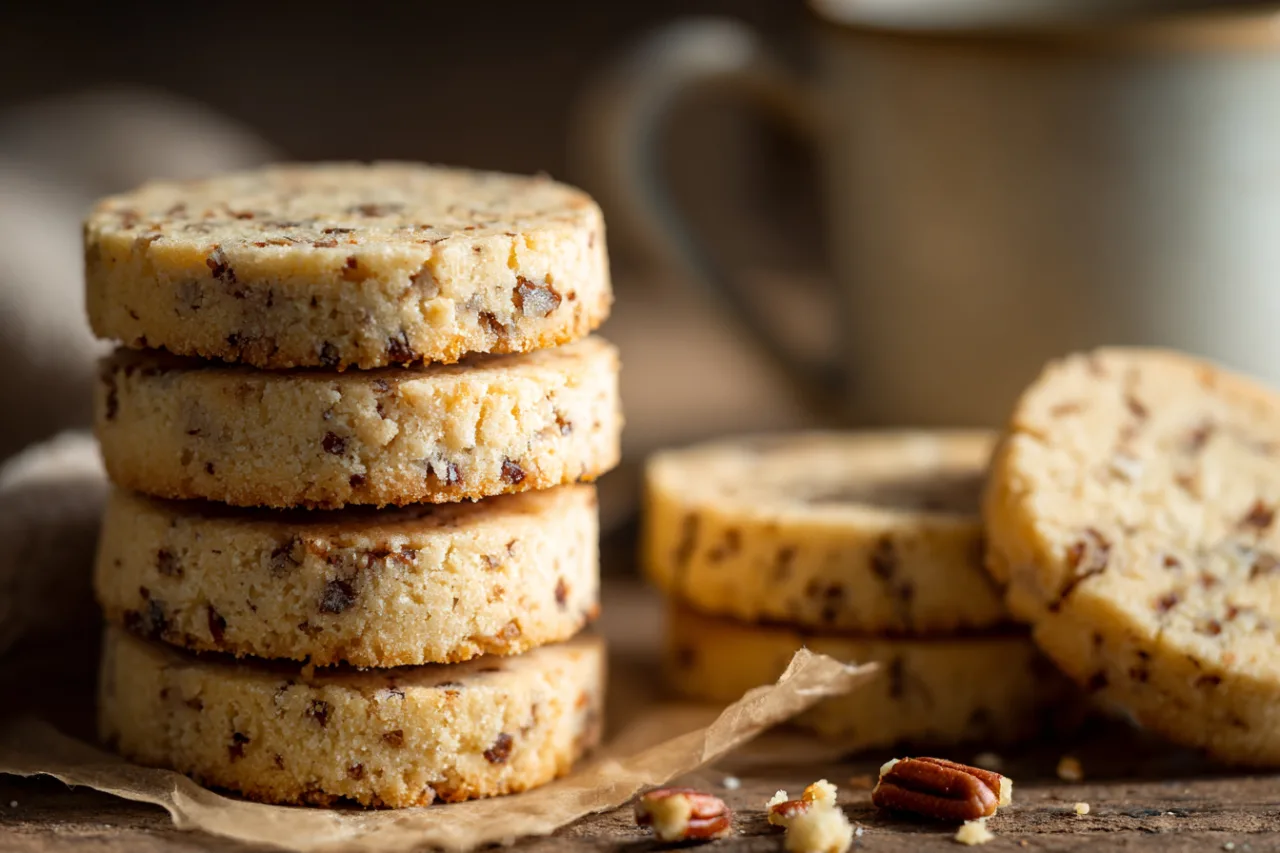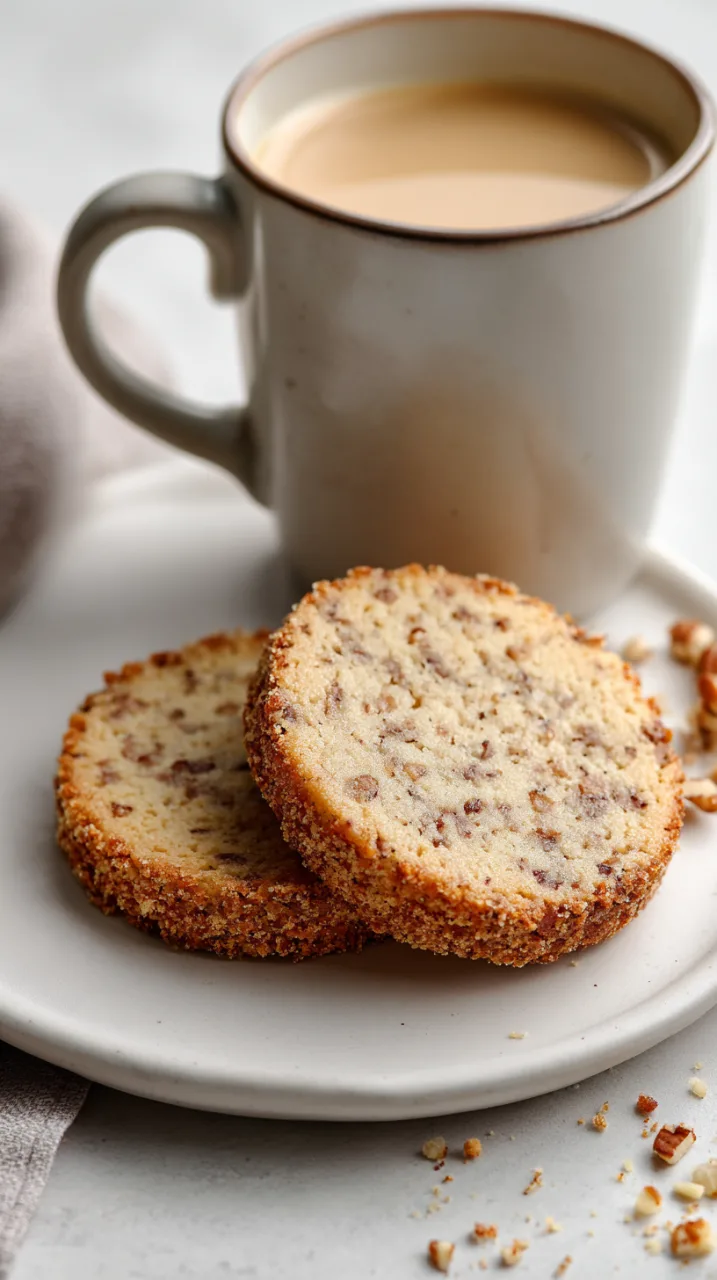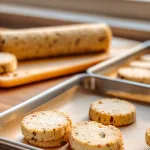Toasted Pecan Shortbread That Smells Like Holidays And Tastes Like Right Now
Shortbread doesn’t beg. It just sits there, quiet, then steals the room. Here’s the rub. So many pecan shortbreads look perfect, then taste shy. Pretty edges, vanilla in the air, and somehow the pecans never show up. I chased that problem for years after service, late bakes when the kitchen was calm and the dish machine hummed like white noise.
The fix was not big, it was tiny choices. Toast the nuts until the color deepens one shade.
Use sugar to sculpt texture, not only to sweeten.
Keep air out of the dough so it bakes tight and clean.
Give the edges a little jacket of pecan and demerara so every bite pops. That is the shortbread sitting in my recipe card for you.
This is the field guide to make it sing.
A quick story. My mom was a shortbread kind of mom. Tins lived on the counter from late October until after Christmas. The cookies would vanish, kids in and out, but the smell hung around, like a warm sweater the house refused to take off. I still hear the lid click. Funny how that sticks.
For a cozy bake to kick off the season, try my pumpkin cousin to this cookie, Pumpkin Chocolate Chip Muffins for an easy fall treat alongside your shortbread.
Why this cookie works when others fade
Toasted pecan shortbread needs a low, steady hum of nut aroma in the crumb and small bursts of nut texture under the tooth.
You get that two ways. Some pecans go very fine so the fat mingles with flour and sugar, which perfumes everything. The rest stay in neat little bits so your teeth actually meet pecan.
That “double pecan” move is the line between pleasant and wow, and it is right here in this recipe.
The other part is restraint. No whipped butter clouds. No frantic mixing. We want smooth, not fluffy. Air lifts. Lift spreads. Spread blurs the edges you worked for.
If terms like “crumb” and “short” feel fuzzy, this plain-English guide to baking terms will make the science of shortbread click fast.
Ingredient deep dive from a coastal kitchen
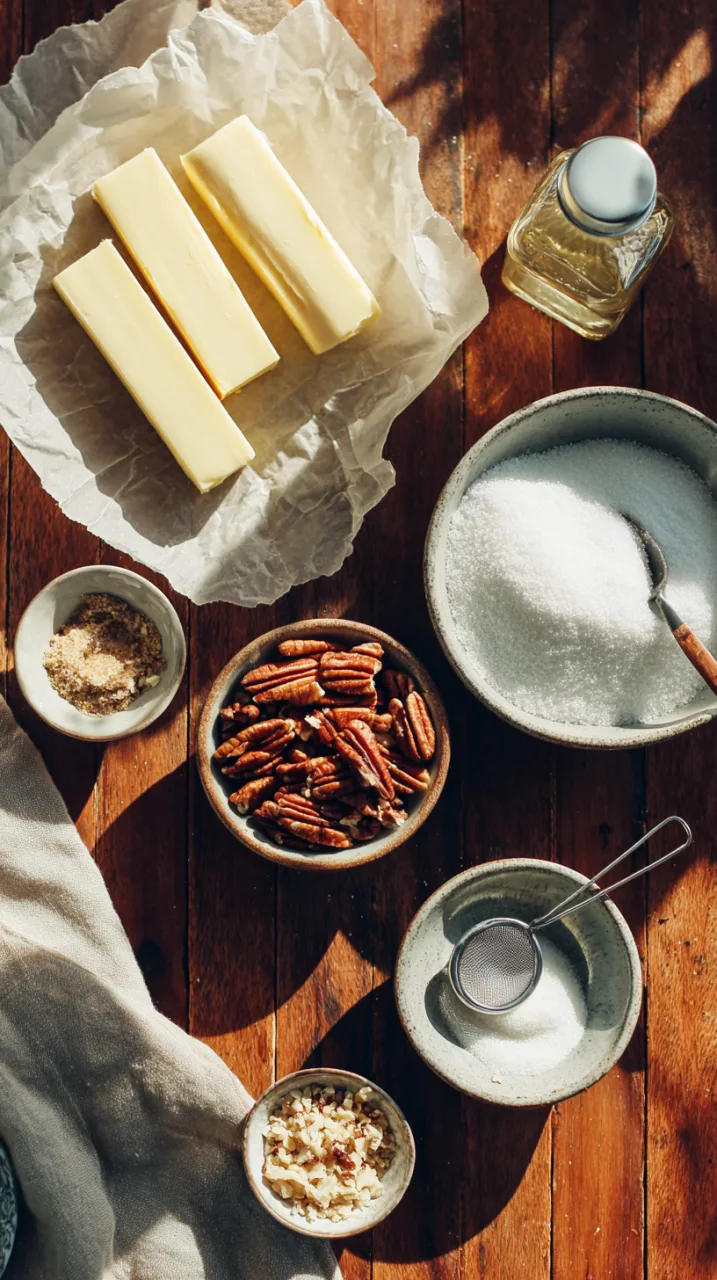
Butter first. I buy unsalted, cool and pliable. If you shop around Santa Cruz or down toward Monterey, local creameries keep butter with a rounder flavor that shows up in simple bakes. Supermarket butter still wins if you treat it kindly. Cool, not cold. Pliable, not greasy. That feel lets the sugar dissolve and coat without beating in bubbles.
Sugar does two jobs here. Confectioners’ sugar melts into a tender crumb, a tight one that breaks clean. A small scoop of light brown sugar leans caramel, very quiet, just enough to partner with pecans and that crunchy rim. Demerara or turbinado give the edge sparkle and snap. If you only have granulated, it still works, the sparkle just lands smaller.
Flour is plain all-purpose. No hero moves. Weigh it if you can. Shortbread is simple, ratios matter, and flour measures are where most home bakes wander off.
Salt is the key you turn at the end. Fine sea salt inside, a tiny pinch of flaky salt in the rim mix. Not enough to read as salty, just enough to wake the butter and nuts. If flaky salt is tough to find, crush a bit of kosher between your fingers and it behaves the same.
Vanilla should smell like pods, not perfume. Keep the bottle away from heat. Hiding it near the stove is how vanilla goes flat.
Pecans must be fresh. I taste before I bake, always. If there is even a hint of stale oil, out they go. I toast on a bare sheet until I can smell pie. That is the cue. The color deepens a hair. Pull them. Cool them fully. Warm nuts will melt your butter, which beats you before you start.
One more small twist that keeps this recipe egg free. I brush the dough logs with melted butter, then roll through the pecan sugar. That thin coat sticks evenly, bakes into a crisp collar, and skips the shiny finish eggs can give. Cleaner bite. Cleaner look. Easy win.
Curious about the crunchy rim; here’s exactly what demerara sugar is and why it adds sparkle without extra sweetness.
Pro method, plain talk
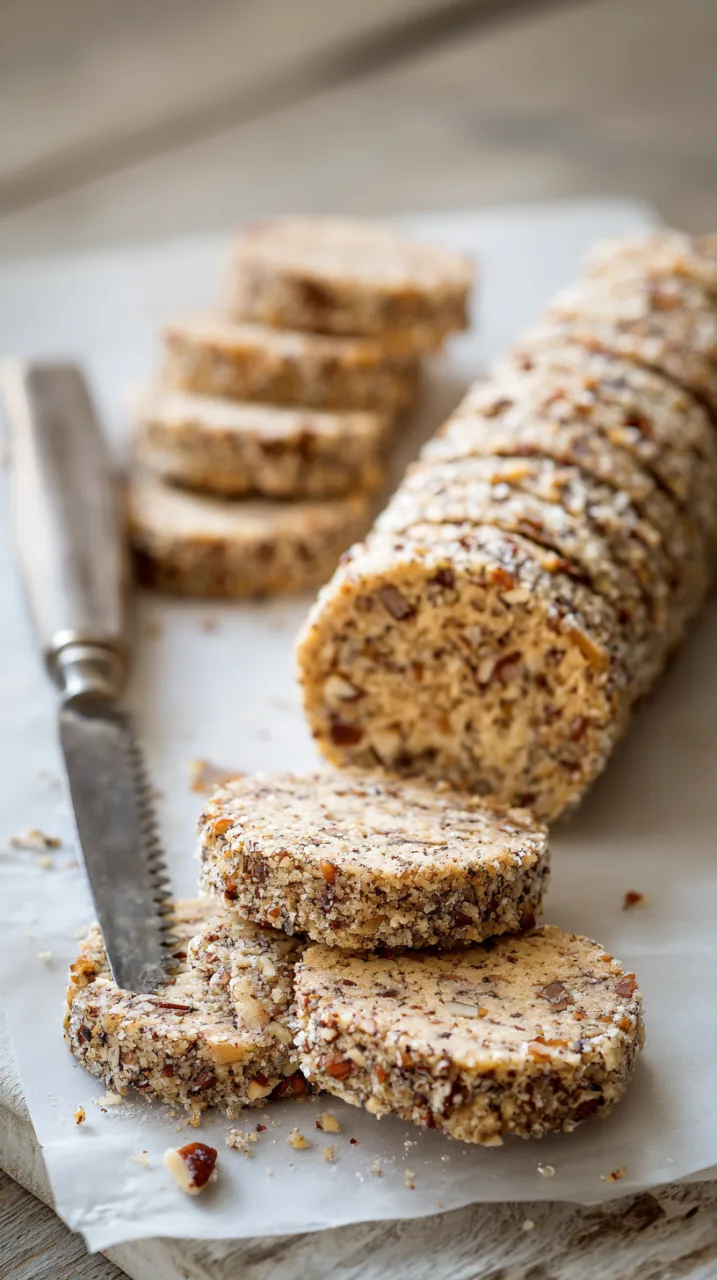
Shortbread rewards calm hands. I mix the butter with confectioners’ sugar and that little brown sugar at medium low until it looks like smooth plaster. Not whipped. Not airy. Just even. Vanilla and salt go in. Then flour and the finely ground pecans go in and I mix only until the last dry speck disappears. Stop there. The chopped pecans get folded in by hand, so they stay neat.
I roll two tidy logs. Round works. Square works. Consistency is the goal so slices bake evenly. Wrap tight. Chill until the logs feel firm all the way through. Two hours in a home fridge is dependable. Overnight is fine, you just let the log rest on the counter a few minutes so the knife does not shatter the slices.
Now the fun part. Melted butter on the outside, light brush, then roll the log through the demerara mix with a spoon or your palm supporting from underneath. The rim sticks in a thin, even coat. Simple. Clean. Looks fancy. Slice a third of an inch. If you like crisper cookies, shave them a bit thinner. If you like a tender center, go a touch thicker. You choose.
Bake on parchment until the edges go lightly golden and the center loses its raw shine. Rotate once if your oven has hot corners. Let the tray sit a couple minutes before moving to a rack. The set happens right there. That last little bit is where the crumb tightens and the smell blooms.
Do imperfect circles drive you wild. There is a trick. Nestle the slices into the wells of a muffin tin, ungreased. The walls keep the rounds perfect while the top browns and the middle sets. You do not need it, but it is a happy trick for gifts or catering when every cookie should look like a twin.
Dial in consistency with this step-by-step on how to measure baking ingredients so your dough slices clean every time. Also, A sturdy board makes cleaner slices; here’s the one I recommend, the Sonder end-grain walnut cutting board.
Troubleshooting from the line
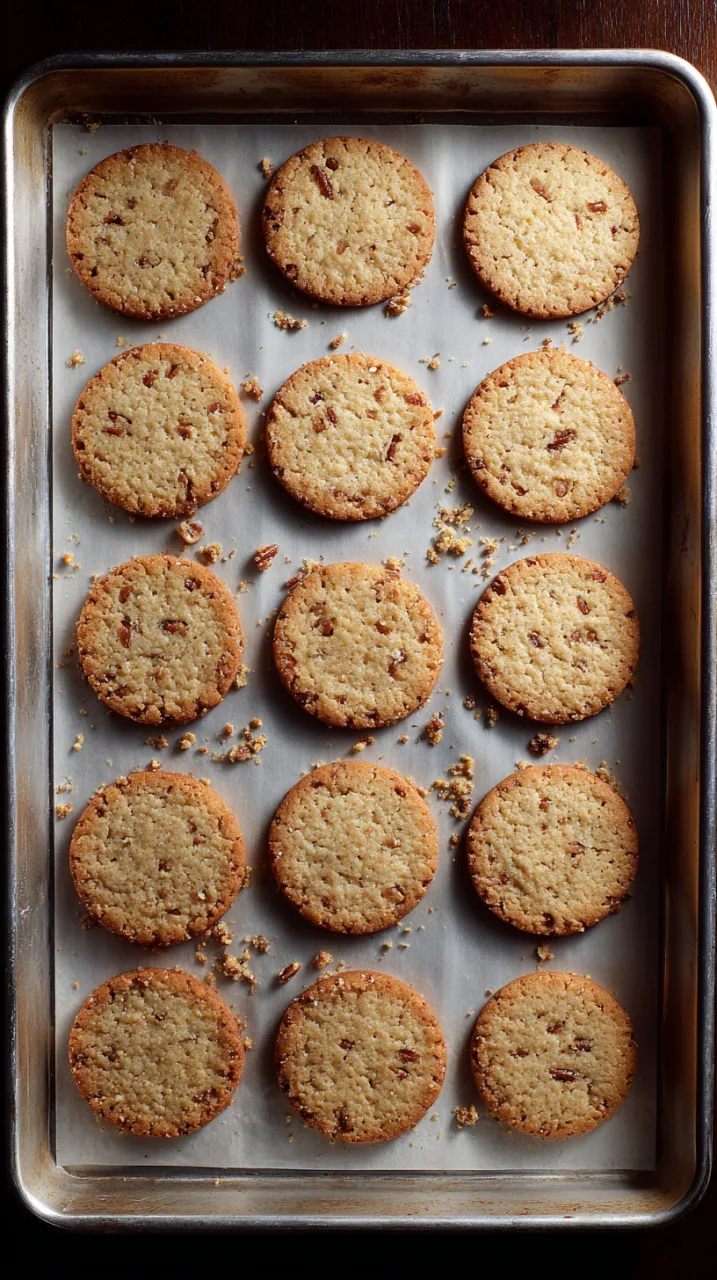
Greasy dough means the butter started too soft. Mix slower next time, or chill the bowl for ten minutes and keep going. Spread means air got whipped in or the logs did not chill long enough. Tighten up your mixing window, keep it smooth not fluffy, and let the logs rest longer. Pale bottoms mean you pulled early. Give the next tray a minute more. If slices crumble under the knife, rest the log five minutes and use a gentle saw with a sharp serrated blade. No pressing down. Let the teeth do the work.
Rim falling off. It happens when the brush is patchy or the sugar is too coarse without enough melted butter. Brush a thin even coat, press the log into the sugar, roll once, done.
Pecans taste quiet. They were either old or under-toasted. Fresh nuts bloom in the oven. Stale ones never wake up.
If your cookies spread or bake too fast, check oven quirks and altitude tips in my home-baker guide to high-altitude baking.
Scaling, service, and real life use
For a family night, bake one tray and keep the second log cold. Warm cookies after dinner feel like a flex even if dinner was pasta and salad.
For a dinner party, I plan three per person if it is the only sweet, two if there is also fruit or a little custard. For a buffet, two per guest is steady.
For catering, I stage logs and bake to order through service. It keeps aroma in the room and the texture snap-on.
I mark logs with tape, time and flavor, so staff can pull in waves. One set ready to slice, one set chilling firm, one set cooling. It looks fussy on paper. In motion it is smooth. Clients notice. They always do.
Storage is friendly. Airtight tin, cool room, one week. If the coastal fog rolls in and the room runs damp, keep the lid on until the minute you serve.
Baked cookies freeze well with parchment between layers. Bring to room temp on a rack.
If you want that just-baked crisp back, warm on a dry sheet for two minutes, not to brown, just to wake.
Planning tins for gifts or a party; use this simple playbook on how to double a recipe without losing texture.
Light nutrition talk, chef to cook
This is a butter cookie, plain and proud. The card’s estimate lands around a small snack per cookie.
Pecans bring good fats and real flavor, which helps you stop at two, unless you do not want to, which happens.
Balance the plate with something bright, a few clementine wedges, thinly sliced pear, or macerated strawberries.
That little lift lets the butter shine without feeling heavy.
Small form factor helps if you watch sugar. Cut the slices a hair thinner and track the bake closely. You could skip the rim, though I would not, that is where the sparkle lives.
If you loved the pecan rim here, you’ll also like my springy Lemon Lavender Shortbread for bright days.
Ingredient swaps that actually keep the soul
Walnuts work if you toast them very gently. They go bitter if they go too far, so watch them. Hazelnuts make a perfumes version, lovely with coffee, still a shortbread, just a different accent.
Dairy free can land if you pick a plant butter with fat levels close to dairy butter. Chill becomes even more important. The texture will not match one hundred percent, the cookie still reads right.
Gluten free needs a one to one baking blend that already includes a binder. Slice steady at that third inch, chill longer, and move gently. The flavor tracks as long as your pecans are fresh.
Confectioners’ sugar in the dough is the classic move. If all you have is granulated, pulse it with part of the pecans until fine, then mix. The texture will be closer to the classic.
No demerara. No problem. Granulated rim still gives a crisp edge. It just looks a little more subtle.
A whisper of cinnamon in the dough plays nice with pecans. Keep it shy. You should sense warmth, not feel like holiday spice took over. You can brown the butter first if you crave a deeper note. Cool it back to pliable before mixing, then chill the finished dough a touch longer before shaping.
If you’re portioning for snacks or bake sales, a quick refresher on what “yield” means helps you plan the right batch size.
Coastal California notes and pairing ideas
The ocean air around Santa Cruz changes how cookies behave. On damp days, lids stay on tins until the last minute.
On dry days, I let the cookies sit out a touch longer, they hold their snap. Farmers’ markets keep me honest. I buy pecans from vendors who can tell me when they roasted and where they came from.
Butter from a small creamery shows up in simple bakes like this.
The finish is clean, the aroma sticks around.
Coffee and tea both love these cookies.
I pour a lighter roast with a little citrus, or a nutty oolong with a soft finish. Wine, I don’t drink anymore, but as a former sommelier, go for a late harvest Riesling or a tawny Port if you want deeper notes.
Cheese board trick, plate shortbread with a small spoon of goat cheese and a thin slice of ripe pear. People side-eye it, then they come back, fast.
For a holiday brunch plate, bake a pan of Cranberry Orange Scones to serve with your pecan shortbread and coffee.
Questions I get all the time
Can I skip chilling
I would not. Chilling sets the butter and lets the flour drink. Skip it and you lose your clean edges.
My cookies spread, what went wrong
Butter was too warm or the dough got whipped. Mix to smooth, not fluffy, and chill until firm all the way through.
Do I need the crunchy rim
You do not need it, but it makes the bite sing. Texture and sparkle, tiny lift, easy step.
Can I freeze the dough
Yes. Wrap the logs well and freeze for three months. Slice straight from frozen and bake a minute longer.
Can I make these gluten free
Use a one to one blend with a binder. Keep everything cold and be gentle when moving slices.
Salted or unsalted butter
Unsalted gives you control. If salted is all you have, shave the added salt by a pinch and try a cookie the next day before you change anything else.
How do I keep them crisp for a party
Bake the morning of, cool fully, store in a tin, open right before serving. If the room is humid, warm them two minutes on a dry sheet.
For home cooks who want a pro finish
Trim the log ends so your first and last slices match the rest.
Rotate the log a quarter turn after every cut for rounder coins.
Use that muffin tin trick if you want perfect circles with zero drama. And bake to the color, not just the clock.
Ovens have opinions.
The edge should wear a faint halo of gold. Pull them. Let them sit. You will hear the room go quiet for a second when the first tray hits the table.
Happens every time.
If you prefer weight over volume for tighter shots and tighter bakes, keep this grams-to-cups conversion handy.
For pros and side hustlers
Shortbread is friendly for sales. It stacks. It ships. It holds flavor.
I label allergens clearly, slide pairs into glassine, and date the back.
Coffee shops love frozen logs. They bake through the day and the shop smells like butter and pecans, which sells more coffee, which means they call me again next week.
Keep a clean spec sheet and a simple costing doc. Tiny operation or big, both need that.
One last nudge from the line
You already have the recipe card with the map.
Toast the pecans until the kitchen smells like a pie shop.
Mix smooth, not airy. Roll tidy logs. Brush, rim, slice. Bake until the edges glow.
Let the first cookie be for you, the second for someone you like a lot, the third for the cook who wandered through the kitchen asking what smells so good.
Then put the lid on the tin and try to make it last until tomorrow.
Toasted Pecan Shortbread Dough Recipe
Print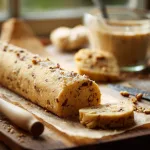
Toasted Pecan Shortbread (Slice-and-Bake)
- Prep Time: 20 minutes
- Chill Time: 2 hours (or up to 3 days)
- Cook Time: 15–18 minutes per tray
- Total Time: about 2 hours 40 minutes
- Yield: about 36 cookies (two 8–9 inch logs, sliced about 1/3 inch thick) 1x
- Category: Dessert, Snack
- Method: Baking
- Cuisine: American
Description
A crisp, buttery shortbread with real toasted pecan flavor. The dough is easy to mix, rolls cleanly into tidy logs, and slices without crumbling. The edges wear a pecan–demerara rim that bakes into a caramel crunch. The bake is even. The finish is tender. The flavor is deep and toasty.
Equipment: stand mixer or food processor; rimmed baking sheets; parchment paper; wire cooling rack; sharp serrated knife; measuring cups and spoons; digital scale (helpful); small bowl; plastic wrap; optional muffin tin for perfectly round cookies
Ingredients
- 1 1/2 cups (150 g) pecan halves, toasted and cooled, divided (see Steps)
- 1 cup (227 g) unsalted butter, cool but pliable
- 3/4 cup (90 g) confectioners’ sugar, sifted
- 2 tbsp (25 g) light brown sugar
- 2 tsp pure vanilla extract
- 1/2 tsp fine sea salt
- 2 cups (240 g) all-purpose flour
Pecan–Demerara Rim:
- 1/3 cup (65 g) demerara or turbinado sugar
- 2 tbsp (10 g) very finely chopped toasted pecans
- 1/4 tsp flaky sea salt
- 1 tbsp (14 g) unsalted butter, melted (for brushing; keeps the dough egg-free)
Instructions
- Toast the pecans. Heat the oven to 350°F. Spread all the pecans on a rimmed sheet. Bake 6–8 minutes until fragrant and a shade deeper. Cool completely.
- Divide the nuts. Very finely chop or pulse 3/4 cup (about 75 g) to a sandy texture. Chop the remaining 3/4 cup to small, even bits. Set aside.
- Make the rim mix. In a small bowl, combine demerara sugar, 2 tbsp very finely chopped pecans, and flaky salt. Set aside.
4A) Mixer method. Beat butter, confectioners’ sugar, and brown sugar on medium-low until smooth and creamy, about 1–2 minutes. Mix in vanilla and fine salt. Add flour and the 3/4 cup finely ground pecans. Mix on low just until a soft dough forms and no dry flour remains. Fold in the 3/4 cup chopped pecans by hand.
4B) Processor method. Pulse the 3/4 cup finely ground pecans with confectioners’ sugar, brown sugar, flour, and fine salt until even. Add butter in chunks and vanilla. Pulse until the dough clumps and holds when pressed. Fold in the 3/4 cup chopped pecans by hand. - Shape and chill. Divide dough in half. Roll each half into a neat log about 1.75 inches in diameter and 8–9 inches long. Wrap tightly in plastic. Chill until very firm, at least 2 hours and up to 3 days. For round logs, roll the wrapped logs a few times during the first 10 minutes of chilling.
- Rim the logs. Unwrap a log. Lightly brush the outside with melted butter. Roll in the pecan–demerara rim mix to coat. Repeat with the second log.
- Slice. Use a sharp serrated knife to cut 1/3-inch slices. If a slice crumbles, let the log sit 3–5 minutes and try again.
- Bake. Line sheets with parchment. Space cookies 1 inch apart. Bake at 350°F for 15–18 minutes, rotating the pans at 8 minutes, until edges are lightly golden and centers look set. For perfect rounds, nestle slices in the wells of an ungreased muffin tin and bake 16–18 minutes.
- Cool and store. Rest cookies on the sheet for 2 minutes. Move to a rack to cool. Cookies crisp as they cool. Store airtight at cool room temperature for up to 1 week.
Notes
Make-Ahead:
- Chill logs up to 3 days.
- Freeze logs up to 3 months. Wrap in plastic, then foil.
- Slice from frozen and add 1–2 minutes to the bake time.
- Baked cookies freeze well for 2 months. Layer with parchment.
Notes:
- Slightly original element here: the rim uses melted butter as the adhesive instead of an egg wash. This keeps the dough fully egg-free, holds the demerara and pecan bits in a thin, even coat, and bakes into a clean caramel snap without a shiny egg sheen. The tiny pinch of flaky salt in the rim wakes up the toasted pecan flavor.
- The “double pecan” approach matters. Finely ground pecans blend with the flour and sugar for aroma, while the chopped pecans give real nut texture in each bite.
- Thickness controls texture. Thin slices bake snappier. Slightly thicker slices bake tender with a light short crumb. Stay near 1/3 inch for balance.
- If spread is a worry, keep your butter cool-pliable, not greasy. Chill the logs firm. Bake from cold sheets. The muffin-tin trick locks in round edges.
- Flavor accents that stay true. A shy pinch of cinnamon in the dough works. Brown the butter and cool it to room temp for a deeper nutty note; if you brown the butter, chill the mixed dough 30 minutes before shaping.
- Allergens. Contains tree nuts, wheat, and dairy.
Troubleshooting:
- Crumbly slices: the log is too cold or the knife is dull. Rest a few minutes and use a clean, gentle sawing motion.
- Greasy dough: butter was too soft. Chill the bowl 10 minutes, then resume.
- Pale bottoms: add 1–2 minutes. The edges should show a light golden ring.
- Uneven rounds: trim the ends, rotate the log a quarter turn after each slice, or bake in a muffin tin.
Storage:
- Room temp, airtight: 7 days.
- Freezer, baked: 2 months.
- Freezer, unbaked logs: 3 months. Slice straight from frozen.
Nutrition
- Serving Size: 1 cookie
- Calories: 115 kcal
- Fat: 8 g
- Carbohydrates: 10 g
- Protein: 1 g

